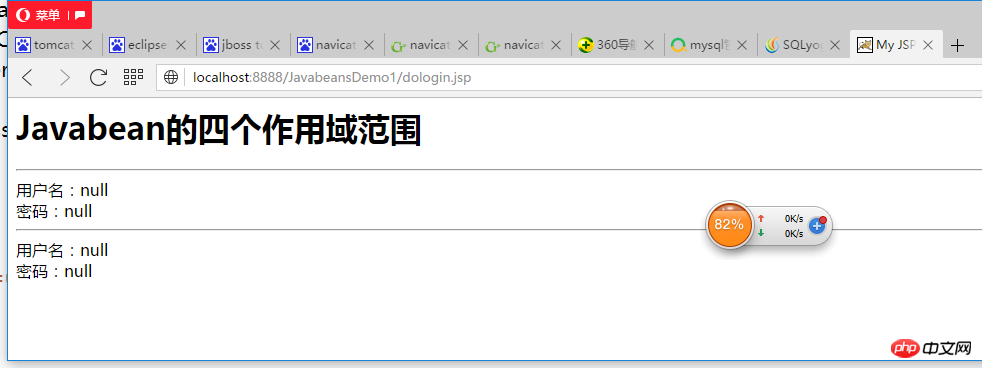Maison >Java >javaDidacticiel >Explication détaillée des quatre portées dans JavaBean
Explication détaillée des quatre portées dans JavaBean
- 黄舟original
- 2017-10-13 10:38:092873parcourir
Cet article présente principalement des informations pertinentes sur l'explication détaillée des quatre portées de JavaBean. J'espère que cet article pourra aider tout le monde. Les amis dans le besoin peuvent se référer à
Les quatre portées de JavaBean Explication détaillée.
Explication
L'utilisation de l'attribut scope de useBeans peut être utilisée pour spécifier la portée de javabean.
Deux ou quatre scopes

Trois codes
1. login.jsp
<%@ page language="java" import="java.util.*" contentType="text/html; charset=utf-8" %>
<%
String path = request.getContextPath();
String basePath = request.getScheme()+"://"+request.getServerName()+":"+request.getServerPort()+path+"/";
%>
<!DOCTYPE HTML PUBLIC "-//W3C//DTD HTML 4.01 Transitional//EN">
<html>
<head>
<base href="<%=basePath%>" rel="external nofollow" rel="external nofollow" rel="external nofollow" >
<title>My JSP 'login.jsp' starting page</title>
<meta http-equiv="pragma" content="no-cache">
<meta http-equiv="cache-control" content="no-cache">
<meta http-equiv="expires" content="0">
<meta http-equiv="keywords" content="keyword1,keyword2,keyword3">
<meta http-equiv="description" content="This is my page">
<!--
<link rel="stylesheet" type="text/css" href="styles.css" rel="external nofollow" rel="external nofollow" rel="external nofollow" >
-->
</head>
<body>
<h1>系统登录</h1>
<hr>
<form name="loginForm" action="dologin.jsp?mypass=999999" method="post">
<table>
<tr>
<td>用户名:</td>
<td><input type="text" name="username" value=""/></td>
</tr>
<tr>
<td>密码:</td>
<td><input type="password" name="password" value=""/></td>
</tr>
<tr>
<td colspan="2" align="center"><input type="submit" value="登录"/></td>
</tr>
</table>
</form>
</body>
</html>2. dologin.jsp
<%@ page language="java" import="java.util.*" contentType="text/html; charset=utf-8"%>
<%
String path = request.getContextPath();
String basePath = request.getScheme()+"://"+request.getServerName()+":"+request.getServerPort()+path+"/";
%>
<!DOCTYPE HTML PUBLIC "-//W3C//DTD HTML 4.01 Transitional//EN">
<html>
<head>
<base href="<%=basePath%>" rel="external nofollow" rel="external nofollow" rel="external nofollow" >
<title>My JSP 'dologin.jsp' starting page</title>
<meta http-equiv="pragma" content="no-cache">
<meta http-equiv="cache-control" content="no-cache">
<meta http-equiv="expires" content="0">
<meta http-equiv="keywords" content="keyword1,keyword2,keyword3">
<meta http-equiv="description" content="This is my page">
<!--
<link rel="stylesheet" type="text/css" href="styles.css" rel="external nofollow" rel="external nofollow" rel="external nofollow" >
-->
</head>
<body>
<jsp:useBean id="myUsers" class="com.po.Users" scope="page"/>
<h1>setProperty动作元素</h1>
<hr>
<!--根据表单自动匹配所有的属性 -->
<%--
<jsp:setProperty name="myUsers" property="*"/>
--%>
<!--根据表单匹配所有部分的属性 -->
<%--
<jsp:setProperty name="myUsers" property="username"/>
--%>
<!--根表单无关,通过手工赋值给属性 -->
<%--
<jsp:setProperty name="myUsers" property="username" value="lisi"/>
<jsp:setProperty name="myUsers" property="password" value="888888"/>
--%>
<!--通过URL传参数给属性赋值 -->
<jsp:setProperty name="myUsers" property="username"/>
<jsp:setProperty name="myUsers" property="password" param="mypass"/>
<!-- 使用传统的表达式方式来获取用户名和密码 -->
<%--
用户名:<%=myUsers.getUsername() %><br>
密码:<%=myUsers.getPassword() %><br>
--%>
<!-- 使用getProperty方式来获取用户名和密码 -->
用户名:<jsp:getProperty name="myUsers" property="username"/> <br>
密码:<jsp:getProperty name="myUsers" property="password"/><br>
<br>
<br>
<a href="testScope.jsp" rel="external nofollow" >测试javabean的四个作用域范围</a>
<%
request.getRequestDispatcher("testScope.jsp").forward(request, response);
%>
</body>
</html> 3. testScope.jsp
<%@ page language="java" import="java.util.*"
contentType="text/html; charset=utf-8"%>
<%@ page import="com.po.Users"%>
<%
String path = request.getContextPath();
String basePath = request.getScheme() + "://"
+ request.getServerName() + ":" + request.getServerPort()
+ path + "/";
%>
<!DOCTYPE HTML PUBLIC "-//W3C//DTD HTML 4.01 Transitional//EN">
<html>
<head>
<base href="<%=basePath%>" rel="external nofollow" rel="external nofollow" rel="external nofollow" >
<title>My JSP 'testScope.jsp' starting page</title>
<meta http-equiv="pragma" content="no-cache">
<meta http-equiv="cache-control" content="no-cache">
<meta http-equiv="expires" content="0">
<meta http-equiv="keywords" content="keyword1,keyword2,keyword3">
<meta http-equiv="description" content="This is my page">
<!--
<link rel="stylesheet" type="text/css" href="styles.css" rel="external nofollow" rel="external nofollow" rel="external nofollow" >
-->
</head>
<body>
<h1>Javabean的四个作用域范围</h1>
<hr>
<jsp:useBean id="myUsers" class="com.po.Users" scope="page" />
用户名:<jsp:getProperty name="myUsers" property="username" /><br> 密码:<jsp:getProperty
name="myUsers" property="password" /><br>
<!-- 使用内置对象获取用户名和密码 -->
<hr>
<%--
用户名:<%=((Users)application.getAttribute("myUsers")).getUsername()%><br>
密码:<%=((Users)application.getAttribute("myUsers")).getPassword() %><br>
--%>
<%--
用户名:<%=((Users)session.getAttribute("myUsers")).getUsername()%><br>
密码:<%=((Users)session.getAttribute("myUsers")).getPassword() %><br>
--%>
<%--
用户名:<%=((Users)request.getAttribute("myUsers")).getUsername()%><br>
密码:<%=((Users)request.getAttribute("myUsers")).getPassword() %><br>
--%>
<%
String username = "";
String password = "";
if (pageContext.getAttribute("myUsers") != null) {
username = ((Users) pageContext.getAttribute("myUsers"))
.getUsername();
password = ((Users) pageContext.getAttribute("myUsers"))
.getPassword();
}
%>
用户名:<%=username%><br> 密码:<%=password%><br>
</body>
</html>Quatre résultats de tests

Ce qui précède est le contenu détaillé de. pour plus d'informations, suivez d'autres articles connexes sur le site Web de PHP en chinois!
Déclaration:
Le contenu de cet article est volontairement contribué par les internautes et les droits d'auteur appartiennent à l'auteur original. Ce site n'assume aucune responsabilité légale correspondante. Si vous trouvez un contenu suspecté de plagiat ou de contrefaçon, veuillez contacter admin@php.cn
Article précédent:Apprentissage du mode proxy JavaArticle suivant:Apprentissage du mode proxy Java

